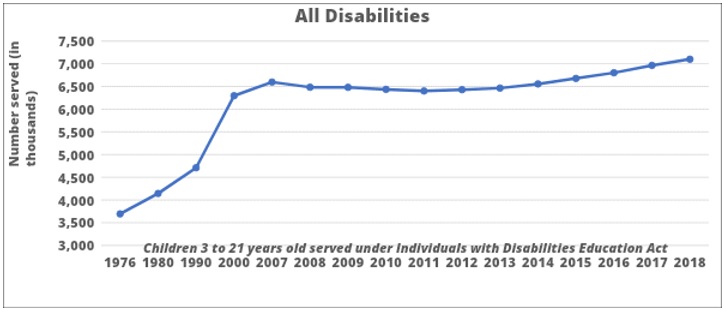Boost Special Need Students Success With IEP Accommodations: A Comprehensive Guide
31st May 2023
If you are a teacher, then you know that each student in your class is unique and has different needs, especially in the case of special needs students. You also know that it is your job to differentiate instruction and make sure that each student has the opportunity to succeed.
One way to do this is to make sure that you are aware of and implementing IEP accommodations and those teachers who have pursued courses like International Teaching Diploma knows it’s effectiveness for special need students.
IEP generally stands for Individualized Education Program and is a document that outlines the specific accommodations and services that a student with an Individualized Education Program (IEP) will receive.
According to onatlas.com survey, “In 2018-2019, 7.1 million students aged 3-21 received special education services under the IDEA, accounting for 14 percent of all public school students in the United States (National Center for Education Statistics, 2020).”

Source: www.onatlas.com/blog/documenting-iep-accommodations-incorporating-best-practices-students-special-needs-still-finding-time-documentation
You might want to know about IEP accommodations and it’s effectiveness more in detail, well this blog has been created to cater to that query only.
So, without any further delay let’s get to know related to IEP accommodations in detail.
What is IEP Accommodations?
IEP Accommodations are modifications to the educational environment and methods that are designed to provide equal access to learning materials and instruction for students with special needs.
These modifications enable students with special needs to understand, participate in, and succeed in the general education curriculum. The IEP team works together to determine which accommodations to include in the student’s Individualized Education Program.
For example, a student with a visual impairment may require textbooks in Braille(a written text for blind people) or large print, while a student with a hearing impairment may require a sign language interpreter. Other accommodations may include extended test-taking time, preferential seating, or access to assistive technology.
Who can receive Accommodations?
IEP accommodations are available to students with special need who meet the eligibility criteria for special education services. IDEA defines 13 categories of impairment that qualify students for special education services, including:
1. Special Learning Needs
This category includes students with learning difficulties in reading, writing, or math, which may be due to cognitive, neurological, or processing deficits. Ex-Dyslexia or Dyscalculia.
2. Other Health Impairment
Students with chronic or acute health problems, such as asthma, diabetes, or epilepsy, that affect their academic performance qualify under this category. Ex- ADHD, Narcolepsy.
3. Autism Spectrum Disorder
Students with difficulties in social interaction, communication, and repetitive behaviours may be classified under this category.
4. Emotional Disturbance
Students with emotional or behavioural disorders, such as anxiety, depression, or ADHD, may qualify for accommodations under this category.
5. Speech or Language Impairment
This category includes students with communication disorders, such as stuttering, articulation, or language disorders.
6. Visual Impairment
Students with partial or total blindness or other visual impairments that affect their ability to read or write may be eligible for accommodations under this category.
7. Deafness
Students with severe to profound hearing loss that impacts their ability to communicate may qualify for accommodations under this category.
8. Hearing Impairment
This category includes students with mild to moderate hearing loss that may require accommodations such as amplification devices or preferential seating.
9. Deaf-Blindness
Students with dual sensory impairments of hearing and vision that severely impact their ability to access information and communicate may qualify under this category.
10. Orthopedic Impairment
This category includes students with physical impairment, such as cerebral palsy, spina bifida, or muscular dystrophy, that affect their mobility or dexterity.
11. Intellectual Impairment
Students with intellectual impairment, such as Down syndrome, that affect their cognitive functioning may qualify for accommodations under this category.
12. Traumatic Brain Injury
Students with brain injuries that affect their cognitive, physical, emotional, or social functioning may be eligible for accommodations under this category.
13. Multiple Special Needs
Students with two or more special needs that significantly impact their ability to learn may qualify for accommodations under this category.
Different Accommodation Categories
IEP accommodations can be organized into several categories based on their focus and purpose. The most common accommodation categories are:
1. Presentation Accommodations
Presentation accommodations refer to how information is presented to the student. For example, a student may require information in a different format, such as audiobooks, videos, or pictures for better understanding.
Presentation Accommodations simply refer to how information can be provided to students effectively.
2. Response Accommodations
Response Accommodations simply mean how students are being able to demonstrate their learning by writing. For example, Students may use a computer, or a scribe or need extra time to complete written assignments.
3. Setting Accommodations
Setting accommodations refer to where students receive instruction or take exams. For example, a student may require a quiet room or preferential seating to minimize distractions.
4. Timing and Scheduling Accommodations
Timing and scheduling accommodations refer to the amount of time students have to complete assignments or exams. For example, a student may require extended time, frequent breaks, or flexible deadlines.
5. Assistive Technology Accommodations
Assistive technology accommodations refer to specialized software or hardware that enables students with special need to access information or complete tasks. For example, a student with a visual impairment may require screen-reading software.
Teachers who have pursued courses like International Teaching Diploma, they know how effective IEP accommodations is for special need students. However, we have included certain tips as well to maximize it’s effectiveness.
Tips for teachers to maximize the effectiveness of IEP accommodations
1. Get to know your student
Knowing the student’s strengths and challenges is essential to understanding his or her individual needs. Building relationships and communicating regularly with parents helps in this regard.
2. Look for patterns
Watch for patterns of success and failure to better understand what is working for the student and what is not.
3. Plan lessons carefully
Pay attention to the specific needs of the student when creating lessons and make sure the curriculum is aligned with their strengths and challenges.
4. Monitor their progress closely
Being on top of changes in their performance is important so that any additional or new accommodations can be implemented to support further success.
5. Provide extra help
Several organizations provide additional help for teachers, such as individualized tutoring for students in need.
6. Advocate for the student
Many teachers play an important role in advocating for their students in the special education system. This includes providing testimony and even talking to the student's team about IEP goals and modifications.
IEP Accommodations is necessary for Special Need Students
Teachers who have pursued courses like International Teaching Diploma, knows that IEP accommodations are essential to ensure that students with special need receive an equal opportunity to access education and demonstrate their learning. The accommodations provided to students with special need aim to remove barriers to learning, not to lower standards or expectations.
Educators, parents, and students should work collaboratively to identify the most appropriate accommodations based on the student's needs and abilities. IEP accommodations can make a significant difference in the lives of students with special need by providing them with the tools and resources they need to achieve their full potential.
Written By : Abhishek
Leave a Reply

